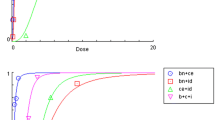Abstract
In preliminary laboratory tests, the joint activity of six benzoylphenylureas (BPUs) was studied by investigating the activity of 90 of their binary mixtures against fourth-instar larvae of the cotton leafworm,Spodoptera littoralis (Boisd.), fed for 72 h on 10 ppm BPU-treated castor bean leaves. Experimental mixing ratios were 1:1, 1:4, and 1:9. At 10 ppm, the activity of the six BPUs was divided into two distinct groups. The first included the more active compounds (XRD-473, GR-333, and chlorfluazuron) while the second was composed of the relatively less active ones (diflubenzuron, triflumuron, and Dowco-439). Results of the assays indicated that only 18 of the 90 tested binary mixtures showed potentiation, whereas the majority, 70 mixtures, exhibited additive effects; two interacted antagonistically. Most of the potentiated pairs were at a mixing ratio of 1:9, pairing one strong BPU (at the low ratio) with a weak one (at the high ratio). The mixing ratio of 1:1 resulted in additive effects.
Similar content being viewed by others
References
Abbott, W.S. (1925) A method of computing the effectiveness of an insecticide.J. econ. Ent. 18: 265–267.
Corbett, J.R. (1974) The Biochemical Mode of Action of Pesticides. Academic Press, Inc., New York, NY.
Dubois, K.P. (1961) Potentiation of the toxicity of organophosphorus compounds.Adv. Pest Control Res. 4: 117–151.
Eldefrawi, M.E., Toppozada, A., Mansour, N.A. and Zeid, M. (1964) Toxicological studies on the Egyptian cotton leafworm,Prodenia litura. I. Susceptibility of different larval instars ofProdenia to insecticides.J. econ. ent. 57:591–593.
El-Guindy, M.A., Abdel-Sattar, M.M. and El-Refai, A.R. (1983) The ovicidal action of insecticides and insect growth regulator/insecticide mixtures on the eggs of various ages of susceptible and diflubenzuron-resistant strains ofSpodoptera littoralis Boisd.Pestic. Sci. 14:253–260.
El-Guindy, M.A., Abdel-Sattar, M.M. and El-Refai, A.M. (1983) The interaction of the insecticides and insect growth regulators on the biotic and reproductive potential of diflubenzuron susceptible and resistant strains ofSpodoptera littoralis Boisd.Z. angew. Ent. 95:75–83.
El-Guindy, M.A., El-Refai, A.R.M. and Abdul-Sattar, M.M. (1983) The joint action of mixtures of insecticides, or of insect growth regulators and insecticides, on susceptible and diflubenzuron-resistant strains ofSpodoptera littoralis Boisd.Pestic. Sci. 14:246–252.
Granett, J. and Retnakaran, A. (1984) Joint action of a juvenile hormone analogue with benzoylphenylureas ingested by western spruce budworm,Choristoneura occidentalis (Lepidoptera: Tortricidae).Can. Ent. 116:1063–1068.
Haga, T., Toki, T., Koyanagi, T. and Nishiyama, R. (1985) Quantitative structure-activity relationships of benzoyl (pyridyl-oxyphenyl) urea insecticides.J. Pestic. Sci. 10:217–223.
Hewlett, P.S. (1960) Joint action in insecticides.Adv. Pest Control Res. 3:27–74.
Ker, R.F. (1978) The effects of diflubenzuron on the growth of insect cuticle.Pestic. Sci. 9:259–265.
Mansour, N.A., Eldefrawi, M.E., Toppozada, A. and Zeid, M. (1966) Toxicological studies on the Egyptian cotton leafworm,Prodenia litura. VI. Potentiation and antagonism of organo-phosphorus and carbamate insecticides.J. econ. Ent. 59:307–311.
Moore, R.F. (1980) Boll weevils: effects of insect growth regulators and juvenile hormone analogues on adult development.J. Ga ent. Soc. 15:227–231.
Mulder, R. and Gijswiit, M.J. (1973) The laboratory evaluation of two promising new insecticides which interfere with cuticle deposition.Pestic. Sci. 4:737–745.
Post, L.C. and Vincent, W.R. (1973) A new insecticide inhibits chitin synthesis.Naturwissenschaften 60:431–432.
Retnakaran, A. and Smith, L. (1975) Morphogenetic effects of an inhibitor of cuticle development of the spruce budworm,Choristoneura fumiferana (Lepidoptera: Tortricidae).Can. Ent. 107:883–886.
Schaefer, C.H., Miura, T., Wilder, W.H. and Mulligan, F.S. III. (1978) New substituted benzamides with promising activity against mosquitoes.J. econ. Ent. 71:427–430.
Sun, Y.P. and Johnson, E.R. (1960) Analysis of joint action of insecticides against house flies.J. econ. Ent. 53:887–892.
Sundaramurthy, V.T. and Balasubramanian, M. (1978) Effect of an inhibitor of chitin deposition in tobacco caterpillar (Spodoptera litura Fb.) under induced hyper hormone condition.Z. angew. Ent. 85:317–321.
Author information
Authors and Affiliations
Rights and permissions
About this article
Cite this article
Radwan, H.S.A., El-Ghar, G.E.S.A. & El-Bermawy, Z.A. Joint action of benzoylphenylureas in binary mixtures against larvae of the cotton leafworm,Spodoptera littoralis . Phytoparasitica 15, 269–276 (1987). https://doi.org/10.1007/BF02979542
Received:
Revised:
Issue Date:
DOI: https://doi.org/10.1007/BF02979542




